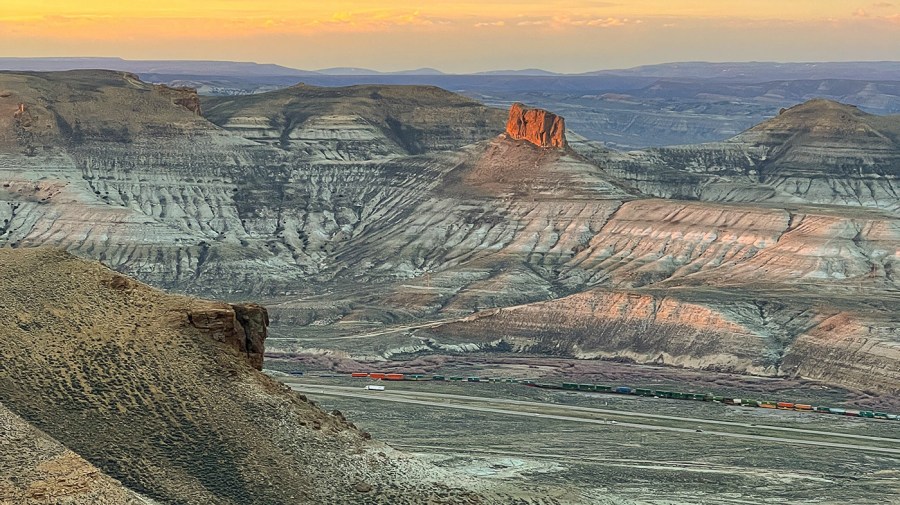Business
Effort to safeguard public lands sparks battle in Wyoming on December 6, 2023 at 11:00 am Business News | The Hill

A Biden administration proposal to safeguard swaths of public land from future mineral and fossil fuel extraction has set off a battle in southwestern Wyoming.
“We’re out there, hiking, running our dogs, working on these lands every day,” Julia Stuble, Wyoming senior manager for The Wilderness Society, told The Hill.
“But they’re not our lands — they’re our lands that are held in trust for all,” she said.
Conflict began brewing over those areas in August, however, when the Bureau of Land Management (BLM) proposed revisions to the ways it administers this 3.6-million-acre swath of federal property.
The BLM offered up a 1,350-page behemoth — a draft “Resource Management Plan” and environmental impact statement — detailing four conservation and development options for the Rock Springs Field Office in southwest Wyoming.
What surprised activists, politicians and industry executives — in some cases for better, and in some cases for worse — was the “preferred alternative” promoted by the BLM in the two-volume document.
This pro-conservation choice, known as Alternative B, would preserve the most land relative to the other options, while restraining activities like mining and extraction.
If Alternative B were to move forward as written, it would bar new fossil fuel or mineral extraction leases on nearly half of the land within the Rock Springs Field Office area.
As Stuble sees it, Wyomingites will face one of two fates as the BLM solidifies its plans: the first, remaining a state in which “public lands continue to produce fossil fuels, and thus contribute to the climate crisis.”
“Or we can have those lands be solutions to that climate crisis,” she said.
Opponents decry ‘federal overreach,’ impact on jobs
Wyoming has long been a national bastion of fossil fuel development and resource extraction — providing a hefty supply of coal, oil, gas and the critical mineral trona.
The biggest coal-generating state since 1986, Wyoming was responsible for about two-fifths of all coal mined in the U.S. in 2022, the U.S. Energy Information Administration (EIA) reported. With regards to fluid fossil fuels, the state is the eighth-largest crude oil producer nationwide and is the ninth-largest generator of natural gas in the nation.
Wyoming also boasts the world’s largest deposit of trona — a resource it draws on to supply about 90 percent of the country’s soda ash, which is used to make glass, soap, cattle feed, paper, pool products, textiles, medicines and toothpaste, per the Wyoming Mining Association.
Beyond the BLM’s preferred alternative, the Rock Springs Resource Management Plan contains three other potential courses of action: one that maintains the status quo, another that favors resource exploitation and a middle-ground compromise on conservation and development.
But if the BLM does adopt its preferred alternative, the agency would classify 1.6 million acres of land — nearly six times today’s share — as Areas of Critical Environmental Concern, a strict conservation designation that generally includes all-out extraction bans.
In total, restrictions on new oil and gas projects across Rock Springs would apply to about 2.19 million acres, representing a 305 percent jump from current conditions. The proposal would also prohibit new wind and solar energy projects, as well as “rights-of-way” corridors — for pipes, transmission lines and maintenance roads — on 2.48 million acres, or 481 percent more than those excluded today. Additionally, the preferred alternative would close 433 percent more land to new coal exploration in comparison to the status quo, while increasing the areas barred to hard-rocking mining claims by 258 percent.
Millions of acres would remain available for exploitation, however: 1.42 million would stay open for new oil and gas projects, and nearly 1 million for new wind and solar projects and rights-of-way corridors.
Grazing, meanwhile, would only face minimal effects: a 0.02 percent cut in accessible acreage.
In advocating for its favored option, the BLM touted the benefits to wildlife habitats and cultural resources. The agency also recognized, however, that “socioeconomic impacts would be the largest due to reduced mineral development.”
Opponents of the BLM proposal, including state lawmakers and development companies, have decried this potential impact on both Wyoming’s economy and the resources it supplies the rest of the country.
“Trona in particular, that’s a fairly limited resource that we have domestically,” state Sen. Brian Boner (R), who opposes the BLM’s preferred alternative, told The Hill.
“I’d hate to be more dependent on foreign nations for such an important resource, especially ones that may not share our values or security concerns,” Boner added.
Reflecting on the BLM’s Resource Management Plan, Ryan McConnaughey, vice president of the Petroleum Association of Wyoming, said in an emailed statement that his organization “could live with any of the alternatives other than Alternative B.”
Citing the BLM’s analysis that this option could lead to 52-percent economic declines and a 73-percent reduction in oil and gas-related jobs, McConnaughey stressed that such development “is the backbone of Wyoming’s economy.”
“Our stance is that the industry is constantly improving technologies and processes that both reduce the costs of production and lessen the impacts on the environment,” he stated.
“The BLM should take those advancements into account at the application for permit to drill level rather than a carte blanche ban on development,” McConnaughey added.
Boner echoed these sentiments, estimating about 3,000 jobs could be lost in a region with just more than 100,000 residents.
The legislator co-chairs the Wyoming state Senate’s Select Federal Natural Resource Management Committee, which is sponsoring legislation that would empower local officials to disregard federal policies they believe don’t comply with federal law.
The text of the bill, which is still under revision, would involve “directing the governor to cease cooperation with federal land management agencies when agencies pursue policies that harm Wyoming,” according to October committee minutes.
The legislation would also establish a full-time position within the governor’s office “to protect Wyoming’s state interests from federal government overreach,” per the minutes.
Wyoming Gov. Mark Gordon (R), too, is among the proposal’s opponents. At the end of September, he sent a letter to the BLM director, requesting the withdrawal of the draft resource management plan and decrying the agency’s preferred alternative as too restrictive.
“As this draft stands it will lack Wyoming’s support, local community support, and will surely be challenged on rigor,” Gordon wrote.
The governor pointed to the efforts that have been underway since 2010 to update the current Rock Springs management plan, noting the 12-year collaborative review process is “either falling on deaf ears or disingenuously being thrown by the wayside.”
Gordon accused the BLM of pulling “a bait-and-switch” on Wyomingites and warned “existing and future partnerships are in jeopardy.”
The BLM extended the mandatory public comment period for the proposal a few weeks later — a gesture for which Gordon expressed his appreciation and that he cited as an opportunity for public engagement.
For the BLM’s part, Wyoming state director Andrew Archuleta at the time issued a statement urging members of the public to participate in the process, noting such comment periods “make our work stronger.”
‘Open and free and wild and intact’
The selection of the pro-conservation option as the preferred alternative was shocking to environmental groups as well — although in their cases, it was largely a pleasant surprise.
In Stuble’s mind, the preferred Alternative B is “remarkably protective of the values that we think that they should be prioritizing.”
She applauded the BLM for proposing “significant conservations” in two key landscapes — the Northern Red Desert and the Big Sandy Foothills — that are rich in habitats for wildlife such as sage grouse, migrating mule deer, migrating pronghorn and both wintering and residential elk.
“These are places people go to recreate, to hunt and fish and camp, walk around, trail run,” Stuble said. “It’s a remarkable area. It’s open and free and wild and intact.”
As far as the potential economic impacts from slashing resource production are concerned, Stuble said certain areas that would face closures have “low to no potential for oil and gas to be found regardless.”
She also stressed the plan would not affect existing leases, which include wells that are currently producing and those that have yet to be drilled.
Stuble further pushed back on criticism regarding the proposal’s potential impact on employment.
The BLM’s analysis for how many jobs would be cut is based on a forecast made in 2011 and was correlated with what officials believed would be the number of wells drilled in the following decade, according to Stuble.
But that number, she explained, was much higher than the actual quantity of wells that ended up materializing in recent years.
“One of the only benefits of having a plan take 10 years is you can actually check the work,” Stuble said.
A vital link between conservation and hunting
Joining activist groups like the Wilderness Society in backing the conservation-focused alternative are a spectrum of groups ranging from avid hunters and recreators to members of local tribal communities.
“I’m not sure why there’s so much opposition to what is being proposed,” Earl DeGroot, a retired management consultant and administrator of the Wyoming Sportsmen for Federal Lands group, told The Hill.
“A lot of what is being proposed would be good for wildlife, and if it’s good for wildlife, it’s good for sportsmen,” he said.
DeGroot voiced his support for the portion of the proposal that would grant 1.6 million acres of land the strictest conservation designation. He stressed that these restrictive classifications would enable the BLM to “evolve some wildlife specific management prescriptions,” such as protections for migration corridors and riparian areas.
DeGroot acknowledged, however, that many people living in the area have dual concerns that revolve around their enjoyment of hunting and their livelihood from resource development.
“It’s kind of a battle between what’s good for me economically and what do I want in terms of hunting opportunities and conservation and aesthetics,” he said.
Dan Stroud, a hunter and retired state biologist, echoed many of these sentiments, explaining that he is generally in favor of the BLM’s preferred alternative, but with some adjustments.
“We need protection of some very important areas for wildlife and some of the other resources, whether they’re cultural or historic trails,” said Stroud, who was a wildlife habitat biologist with the Wyoming Game and Fish Department.
In Stroud’s mind, there are five or six areas within Rock Springs that warrant specific attention — particularly the Big Sandy Foothills region, also known as the “Golden Triangle.”
This region, he explained, is home to one of the longest mule deer corridors in the nation and has one of the densest sage grouse populations.
“It’s really important from the standpoint of wildlife and their future that we pay attention to their needs,” Stroud said.
For Jason Baldes, an Eastern Shoshone tribal member, the need for conservation protections in Rock Springs extends beyond wildlife to also include centuries of cultural history.
The U.S. government’s original treaty with the Eastern Shoshone tribe, he explained, contained the entirety of this high-desert area and included more than 44 million acres before the overlapping states were even established.
The tribe’s cultural connections to the region include petroglyphs, pictographs, spiritual spots, burial grounds, campsites and relics of a vast trade network, according to Baldes.
“We want to protect these places for future generations,” said Baldes, who manages the tribe’s buffalo herd and serves as executive director of the Wind River Tribal Buffalo Initiative.
“The exploitation and extractive industries and the commodification of land and resources is detrimental,” he said. “Preservation, leaving things as they are, is an important endeavor.”
Opportunities for compromise?
While it’s difficult to predict whether the various Rock Springs stakeholders will be able to find an agreeable balance, Stuble said the governor is assembling a task force to figure out if there is some common ground.
“Time will tell in the next couple of weeks as that task force comes together, but there are shared values among people of different interests here in Wyoming,” she continued.
As discussions continue to unfold, Boner expressed what he described as “procedural concerns” about the BLM’s surprise decision to back away from a compromise solution.
“There was a middle-of-the-road option, which I may not agree with, but certainly wouldn’t be strongly opposed to either,” Boner said.
Regarding the need to balance development and wildlife preservation, Boner stressed his belief that local stakeholders have been doing this successfully for years together.
“The problem is if the federal government comes in and tries to do it their way, you’re going to lose a lot of the collaboration you need,” he said, noting this “checkerboard” region of Wyoming also includes private landowners.
“Without their support, there’s nothing stopping them from disrupting those migration corridors, if they feel like the BLM is also threatening their livelihood,” Boner added.
Micky Fisher, spokesperson for the Wyoming BLM, stressed in an emailed statement that “no decisions have been made at this juncture” as the process has only reached the public comment phase. Until a final environmental impact statement has been approved, he continued, the entire “range of alternatives and each component within remains on the table.”
“We’ll compile and leverage all the substantive comments to make an informed final decision,” Fisher added.
With the public comment deadline of Jan. 17 rapidly approaching, Stuble expressed some optimism about the potential for compromise — and about the BLM’s openness to making adjustments to the plan.
“You have folks who work in oil and gas field who are out hunting, or who are out driving around and enjoying wild spaces too,” Stuble said.
“People who are out there recreating in wild spaces, who see themselves as conservationists, are relying on these fuels and these products for our daily life as well,” she added.
Baldes likewise said that while he is pleased with the BLM’s preferred alternative, he understands there will have to be some compromise.
But he cautioned against making decisions based on commodifying resources and maximizing extraction.
“What I’ve grown up with is an understanding of finding common ground between Western science, Indigenous science,” Baldes said.
“That’s often aligned around conservation values of wildlife corridors, migration and biodiversity, and those are more preferable in my perspective,” he added.
Equilibrium & Sustainability, Business, Energy & Environment, News, Policy, State Watch A Biden administration proposal to safeguard swaths of public land from future mineral and fossil fuel extraction has set off a battle in southwestern Wyoming. “We’re out there, hiking, running our dogs, working on these lands every day,” Julia Stuble, Wyoming senior manager for The Wilderness Society, told The Hill. “But they’re not our lands…
Business
Google Accused Of Favoring White, Asian Staff As It Reaches $28 Million Deal That Excludes Black Workers

Google has tentatively agreed to a $28 million settlement in a California class‑action lawsuit alleging that white and Asian employees were routinely paid more and placed on faster career tracks than colleagues from other racial and ethnic backgrounds.
- A Santa Clara County Superior Court judge has granted preliminary approval, calling the deal “fair” and noting that it could cover more than 6,600 current and former Google workers employed in the state between 2018 and 2024.

How The Discrimination Claims Emerged
The lawsuit was brought by former Google employee Ana Cantu, who identifies as Mexican and racially Indigenous and worked in people operations and cloud departments for about seven years. Cantu alleges that despite strong performance, she remained stuck at the same level while white and Asian colleagues doing similar work received higher pay, higher “levels,” and more frequent promotions.
Cantu’s complaint claims that Latino, Indigenous, Native American, Native Hawaiian, Pacific Islander, and Alaska Native employees were systematically underpaid compared with white and Asian coworkers performing substantially similar roles. The suit also says employees who raised concerns about pay and leveling saw raises and promotions withheld, reinforcing what plaintiffs describe as a two‑tiered system inside the company.
Why Black Employees Were Left Out
Cantu’s legal team ultimately agreed to narrow the class to employees whose race and ethnicity were “most closely aligned” with hers, a condition that cleared the path to the current settlement.

The judge noted that Black employees were explicitly excluded from the settlement class after negotiations, meaning they will not share in the $28 million payout even though they were named in earlier versions of the case. Separate litigation on behalf of Black Google employees alleging racial bias in pay and promotions remains pending, leaving their claims to be resolved in a different forum.
What The Settlement Provides
Of the $28 million total, about $20.4 million is expected to be distributed to eligible class members after legal fees and penalties are deducted. Eligible workers include those in California who self‑identified as Hispanic, Latinx, Indigenous, Native American, American Indian, Native Hawaiian, Pacific Islander, and/or Alaska Native during the covered period.
Beyond cash payments, Google has also agreed to take steps aimed at addressing the alleged disparities, including reviewing pay and leveling practices for racial and ethnic gaps. The settlement still needs final court approval at a hearing scheduled for later this year, and affected employees will have a chance to opt out or object before any money is distributed.
H2: Google’s Response And The Broader Stakes
A Google spokesperson has said the company disputes the allegations but chose to settle in order to move forward, while reiterating its public commitment to fair pay, hiring, and advancement for all employees. The company has emphasized ongoing internal audits and equity initiatives, though plaintiffs argue those efforts did not prevent or correct the disparities outlined in the lawsuit.
For many observers, the exclusion of Black workers from the settlement highlights the legal and strategic complexities of class‑action discrimination cases, especially in large, diverse workplaces. The outcome of the remaining lawsuit brought on behalf of Black employees, alongside this $28 million deal, will help define how one of the world’s most powerful tech companies is held accountable for alleged racial inequities in pay and promotion.
Business
Luana Lopes Lara: How a 29‑Year‑Old Became the Youngest Self‑Made Woman Billionaire

At just 29, Luana Lopes Lara has taken a title that usually belongs to pop stars and consumer‑app founders.
Multiple business outlets now recognize her as the world’s youngest self‑made woman billionaire, after her company Kalshi hit an 11 billion dollar valuation in a new funding round.
That round, a 1 billion dollar Series E led by Paradigm with Sequoia Capital, Andreessen Horowitz, CapitalG and others participating, instantly pushed both co‑founders into the three‑comma club. Estimates place Luana’s personal stake at roughly 12 percent of Kalshi, valuing her net worth at about 1.3 billion dollars—wealth tied directly to equity she helped create rather than inheritance.

Kalshi itself is a big part of why her ascent matters.
Founded in 2019, the New York–based company runs a federally regulated prediction‑market exchange where users trade yes‑or‑no contracts on real‑world events, from inflation reports to elections and sports outcomes.
As of late 2025, the platform has reached around 50 billion dollars in annualized trading volume, a thousand‑fold jump from roughly 300 million the year before, according to figures cited in TechCrunch and other financial press. That hyper‑growth convinced investors that event contracts are more than a niche curiosity, and it is this conviction—expressed in billions of dollars of new capital—that turned Luana’s share of Kalshi into a billion‑dollar fortune almost overnight.
Her path to that point is unusually demanding even by founder standards. Luana grew up in Brazil and trained at the Bolshoi Theater School’s Brazilian campus, where reports say she spent up to 13 hours a day in class and rehearsal, competing for places in a program that accepts fewer than 3 percent of applicants. After a stint dancing professionally in Austria, she pivoted into academics, enrolling at the Massachusetts Institute of Technology to study computer science and mathematics and later completing a master’s in engineering.
During summers she interned at major firms including Bridgewater Associates and Citadel, gaining a front‑row view of how global macro traders constantly bet on future events—but without a simple, regulated way for ordinary people to do the same.

That realization shaped Kalshi’s founding thesis and ultimately her billionaire status. Together with co‑founder Tarek Mansour, whom she met at MIT, Luana spent years persuading lawyers and U.S. regulators that a fully legal event‑trading exchange could exist under commodities law. Reports say more than 60 law firms turned them down before one agreed to help, and the company then spent roughly three years in licensing discussions with the Commodity Futures Trading Commission before gaining approval. The payoff is visible in 2025’s numbers: an 11‑billion‑dollar valuation, a 1‑billion‑dollar fresh capital injection, and a founder’s stake that makes Luana Lopes Lara not just a compelling story but a data point in how fast wealth can now be created at the intersection of finance, regulation, and software.
Business
Harvard Grads Jobless? How AI & Ghost Jobs Broke Hiring

America’s job market is facing an unprecedented crisis—and nowhere is this more painfully obvious than at Harvard, the world’s gold standard for elite education. A stunning 25% of Harvard’s MBA class of 2025 remains unemployed months after graduation, the highest rate recorded in university history. The Ivy League dream has become a harsh wakeup call, and it’s sending shockwaves across the professional landscape.

Jobless at the Top: Why Graduates Can’t Find Work
For decades, a Harvard diploma was considered a golden ticket. Now, graduates send out hundreds of résumés, often from their parents’ homes, only to get ghosted or auto-rejected by machines. Only 30% of all 2025 graduates nationally have found full-time work in their field, and nearly half feel unprepared for the workforce. “Go to college, get a good job“—that promise is slipping away, even for the smartest and most driven.
Tech’s Iron Grip: ATS and AI Gatekeepers
Applicant tracking systems (ATS) and AI algorithms have become ruthless gatekeepers. If a résumé doesn’t perfectly match the keywords or formatting demanded by the bots, it never reaches human eyes. The age of human connection is gone—now, you’re just a data point to be sorted and discarded.
AI screening has gone beyond basic qualifications. New tools “read” for inferred personality and tone, rejecting candidates for reasons they never see. Worse, up to half of online job listings may be fake—created simply to collect résumés, pad company metrics, or fulfill compliance without ever intending to fill the role.
The Experience Trap: Entry-Level Jobs Require Years
It’s not just Harvard grads who are hurting. Entry-level roles demand years of experience, unpaid internships, and portfolios that resemble a seasoned professional, not a fresh graduate. A bachelor’s degree, once the key to entry, is now just the price of admission. Overqualified candidates compete for underpaid jobs, often just to survive.
One Harvard MBA described applying to 1,000 jobs with no results. Companies, inundated by applications, are now so selective that only those who precisely “game the system” have a shot. This has fundamentally flipped the hiring pyramid: enormous demand for experience, shrinking chances for new entrants, and a brutal gauntlet for anyone not perfectly groomed by internships and coaching.
Burnout Before Day One
The cost is more than financial—mental health and optimism are collapsing among the newest generation of workers. Many come out of elite programs and immediately end up in jobs that don’t require degrees, or take positions far below their qualifications just to pay the bills. There’s a sense of burnout before careers even begin, trapping talent in a cycle of exhaustion, frustration, and disillusionment.
Cultural Collapse: From Relationships to Algorithms
What’s really broken? The culture of hiring itself. Companies have traded trust, mentorship, and relationships for metrics, optimizations, and cost-cutting. Managers no longer hire on potential—they rely on machines, rankings, and personality tests that filter out individuality and reward those who play the algorithmic game best.
AI has automated the very entry-level work that used to build careers—research, drafting, and analysis—and erased the first rung of the professional ladder for thousands of new graduates. The result is a workforce filled with people who know how to pass tests, not necessarily solve problems or drive innovation.
The Ghost Job Phenomenon
Up to half of all listings for entry-level jobs may be “ghost jobs”—positions posted online for optics, compliance, or future needs, but never intended for real hiring. This means millions of job seekers spend hours on applications destined for digital purgatory, further fueling exhaustion and cynicism.
Not Lazy—Just Locked Out
Despite the headlines, the new class of unemployed graduates is not lazy or entitled—they are overqualified, underleveraged, and battered by a broken process. Harvard’s brand means less to AI and ATS systems than the right keyword or résumé format. Human judgment has been sidelined; individuality is filtered out.

What’s Next? Back to Human Connection
Unless companies rediscover the value of human potential, mentorship, and relationships, the job search will remain a brutal numbers game—one that even the “best and brightest” struggle to win. The current system doesn’t just hurt workers—it holds companies back from hiring bold, creative talent who don’t fit perfect digital boxes.
Key Facts:
- 25% of Harvard MBAs unemployed, highest on record
- Only 30% of 2025 grads nationwide have jobs in their field
- Nearly half of grads feel unprepared for real work
- Up to 50% of entry-level listings are “ghost jobs”
- AI and ATS have replaced human judgment at most companies
If you’ve felt this struggle—or see it happening around you—share your story in the comments. And make sure to subscribe for more deep dives on the reality of today’s economy and job market.
This is not just a Harvard problem. It’s a sign that America’s job engine is running on empty, and it’s time to reboot—before another generation is locked out.

 Entertainment4 weeks ago
Entertainment4 weeks agoWicked Sequel Disappoints Fans: Audience Verdict on For Good

 Entertainment4 weeks ago
Entertainment4 weeks agoAriana & Cynthia Say They’re in a ‘Non‑Demi Curious, Semi‑Binary’ Relationship… WTF Does That Even Mean?

 News4 weeks ago
News4 weeks agoMexico Bans Dophin Shows Nationwide

 Entertainment4 weeks ago
Entertainment4 weeks agoColombia’s ‘Doll’ Arrest: Police Say a 23-Year-Old Orchestrated Hits, Including Her Ex’s Murder

 Entertainment4 weeks ago
Entertainment4 weeks agoHow The Grinch Became The Richest Christmas Movie Ever

 Entertainment4 weeks ago
Entertainment4 weeks agoMiley Cyrus Is Engaged to Maxx Morando

 Business3 weeks ago
Business3 weeks agoLuana Lopes Lara: How a 29‑Year‑Old Became the Youngest Self‑Made Woman Billionaire

 News4 weeks ago
News4 weeks agoUS May Completely Cut Income Tax Due to Tariff Revenue






























